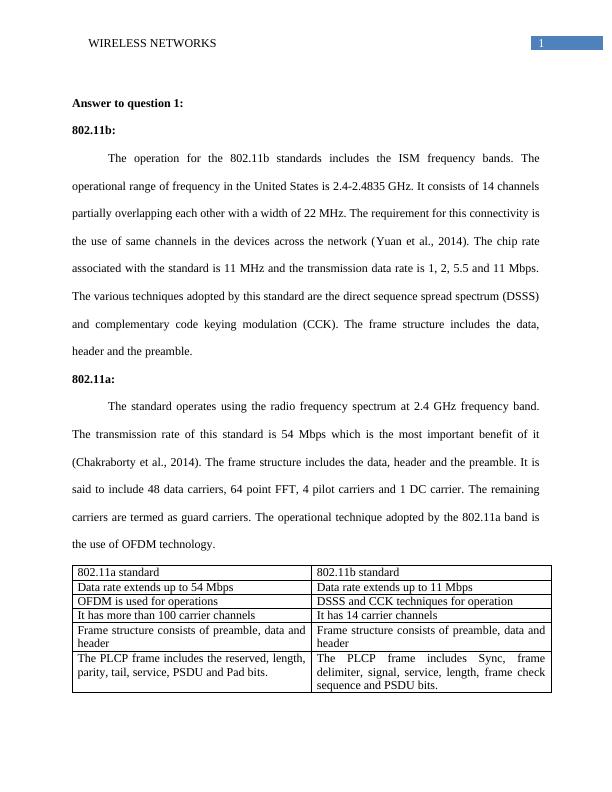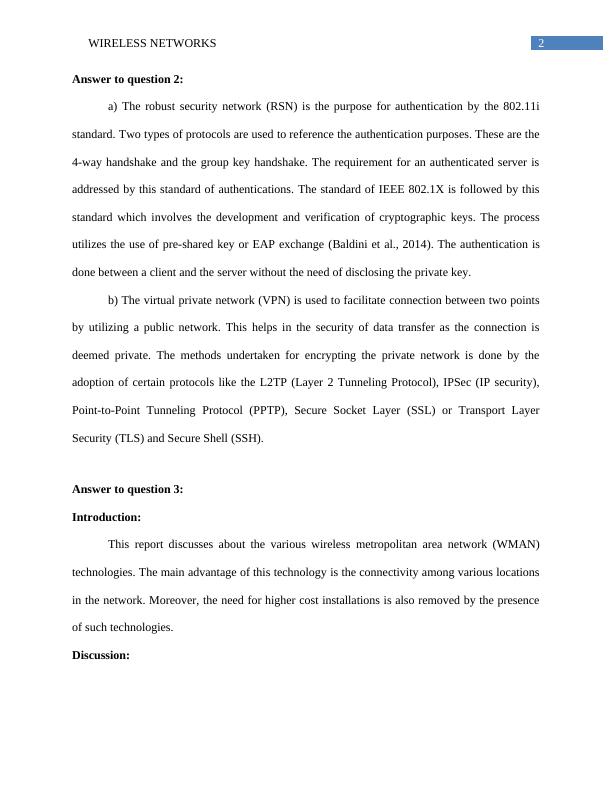The Operational Range of Frequency
8 Pages1886 Words54 Views
Added on 2020-03-16
The Operational Range of Frequency
Added on 2020-03-16
ShareRelated Documents
Running head: WIRELESS NETWORKSWireless networksName of the studentName of the UniversityAuthor Note

1WIRELESS NETWORKSAnswer to question 1:802.11b:The operation for the 802.11b standards includes the ISM frequency bands. Theoperational range of frequency in the United States is 2.4-2.4835 GHz. It consists of 14 channelspartially overlapping each other with a width of 22 MHz. The requirement for this connectivity isthe use of same channels in the devices across the network (Yuan et al., 2014). The chip rateassociated with the standard is 11 MHz and the transmission data rate is 1, 2, 5.5 and 11 Mbps.The various techniques adopted by this standard are the direct sequence spread spectrum (DSSS)and complementary code keying modulation (CCK). The frame structure includes the data,header and the preamble. 802.11a:The standard operates using the radio frequency spectrum at 2.4 GHz frequency band.The transmission rate of this standard is 54 Mbps which is the most important benefit of it(Chakraborty et al., 2014). The frame structure includes the data, header and the preamble. It issaid to include 48 data carriers, 64 point FFT, 4 pilot carriers and 1 DC carrier. The remainingcarriers are termed as guard carriers. The operational technique adopted by the 802.11a band isthe use of OFDM technology. 802.11a standard802.11b standardData rate extends up to 54 MbpsData rate extends up to 11 MbpsOFDM is used for operationsDSSS and CCK techniques for operationIt has more than 100 carrier channelsIt has 14 carrier channelsFrame structure consists of preamble, data andheaderFrame structure consists of preamble, data andheaderThe PLCP frame includes the reserved, length,parity, tail, service, PSDU and Pad bits. The PLCP frame includes Sync, framedelimiter, signal, service, length, frame checksequence and PSDU bits.

2WIRELESS NETWORKSAnswer to question 2:a) The robust security network (RSN) is the purpose for authentication by the 802.11istandard. Two types of protocols are used to reference the authentication purposes. These are the4-way handshake and the group key handshake. The requirement for an authenticated server isaddressed by this standard of authentications. The standard of IEEE 802.1X is followed by thisstandard which involves the development and verification of cryptographic keys. The processutilizes the use of pre-shared key or EAP exchange (Baldini et al., 2014). The authentication isdone between a client and the server without the need of disclosing the private key. b) The virtual private network (VPN) is used to facilitate connection between two pointsby utilizing a public network. This helps in the security of data transfer as the connection isdeemed private. The methods undertaken for encrypting the private network is done by theadoption of certain protocols like the L2TP (Layer 2 Tunneling Protocol), IPSec (IP security),Point-to-Point Tunneling Protocol (PPTP), Secure Socket Layer (SSL) or Transport LayerSecurity (TLS) and Secure Shell (SSH). Answer to question 3:Introduction:This report discusses about the various wireless metropolitan area network (WMAN)technologies. The main advantage of this technology is the connectivity among various locationsin the network. Moreover, the need for higher cost installations is also removed by the presenceof such technologies. Discussion:

End of preview
Want to access all the pages? Upload your documents or become a member.
Related Documents
Wireless Connectivity- Assignmentlg...
|9
|2154
|31
Inner Workings of the Physical Layer of IEEElg...
|11
|2500
|82
Wireless Digital Communications Assignmentlg...
|9
|1877
|266
Wireless Networks Assignmentlg...
|12
|2732
|95
Wireless Network: 802.11 Standards, Router Comparison and Network Setuplg...
|10
|2961
|255
Outlines a Wireless Local Area Networklg...
|9
|2033
|187
